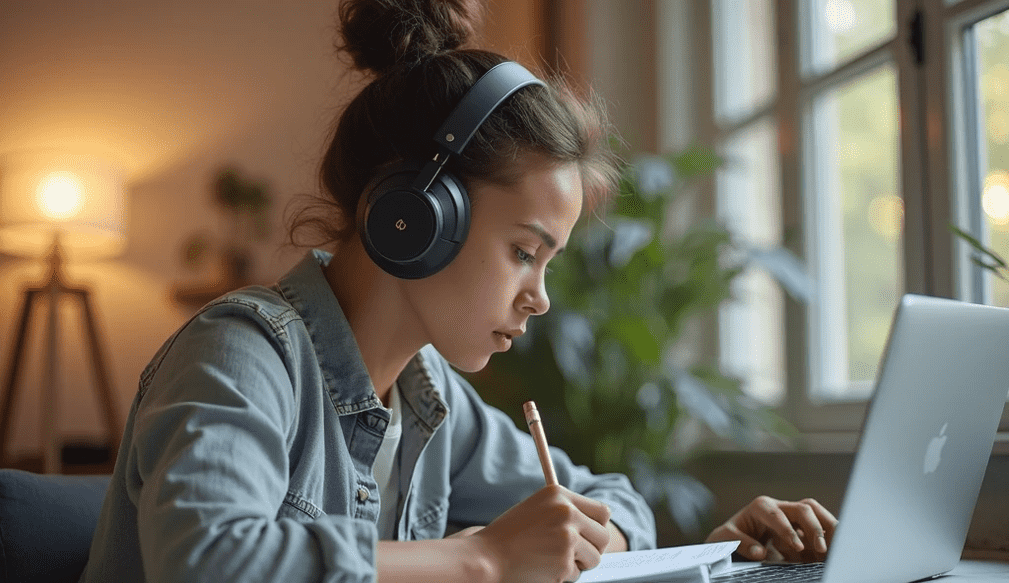The Ultimate Guide to Soundscapes for Studying & Focus: A Guided Session Approach
Published on July 27, 2024 by the Guided Timer Team

Key Takeaways
- Soundscapes mask distractions and can improve focus and creativity.
- Binaural beats in Alpha or Beta ranges can entrain brainwaves for different focus states.
- Colored noises (White, Pink, Brown) are excellent for blocking external disturbances.
- Nature and ambient sounds provide a non-distracting background that calms the mind.
- Experimentation is key. Use the Guided Timer AI Soundscape Suggester to find what works best for you.
In a world saturated with notifications and distractions, finding a pocket of pure focus can feel impossible. Even in a quiet room, your own thoughts can be the loudest distraction. This is where the power of soundscapes comes in. The right audio background can act as a shield, masking disruptive noises, calming a restless mind, and creating the perfect environment for deep work and effective studying.
1. Brainwave Entrainment: Binaural Beats
Binaural beats are a form of sound wave therapy. They work by playing slightly different frequencies in each ear through headphones. Your brain perceives the difference as a single new frequency, which can gently guide your brainwaves into a desired state. For studying, look for beats in these ranges:
- Alpha Waves (8-13 Hz): Ideal for relaxed focus, creative thinking, and absorbing new information.
- Beta Waves (13-30 Hz): Best for active concentration, problem-solving, and high-engagement tasks.
2. Masking Noise: White, Pink, and Brown Noise
These "colors" of noise are your best defense against a noisy environment. They work by covering up sudden, jarring sounds like a door slamming or a dog barking, creating a consistent audio blanket.
- White Noise: Contains all audible frequencies at equal intensity. It's sharp and hissy, like TV static.
- Pink Noise: Deeper than white noise, with more power in lower frequencies. It sounds less harsh, like steady rain or rustling leaves.
- Brown Noise: Even deeper and more "rumbly," like a strong waterfall or distant thunder. Many find this the most grounding and least distracting.
Tired of Guessing?
Stop scrolling through endless playlists. Let our AI psychoacoustics expert find your perfect focus soundscape in one click.
Get Your AI Suggestion3. Natural Ambiences: Nature Sounds
There's a reason we feel calmer in nature. The gentle, non-repeating, and complex patterns of natural sounds are inherently soothing to the human brain. Sounds like a babbling brook, a crackling fireplace, or a forest ambience are fantastic choices. They are engaging enough to prevent your mind from wandering but not structured enough to demand your active attention.
4. Rhythmic Focus: Ambient and Lo-fi Music
If silence feels too sterile, instrumental music is a great option. Lo-fi hip-hop and ambient electronic music are specifically designed for background listening. They feature simple, repetitive chord progressions, no jarring vocals, and a steady rhythm that can help you maintain a consistent work pace without hijacking your focus.
Frequently Asked Questions (FAQ)
Is it better to study in silence or with sound?
It's highly personal, but research suggests that for many people, the right kind of background sound is superior to complete silence. It helps mask unpredictable external noises and can prevent your mind from wandering in an environment that is "too quiet."
Do I need special headphones for binaural beats?
Yes, you need to use stereo headphones for binaural beats to work correctly, as they rely on sending a different frequency to each ear.
How do I find the right soundscape for me?
The key is experimentation! Everyone's brain responds differently. Pay attention to how you feel: are you energized and focused, or are you distracted and annoyed? For a personalized starting point, use the AI Soundscape Suggester in the Guided Timer app to get a recommendation based on your specific task and mood.